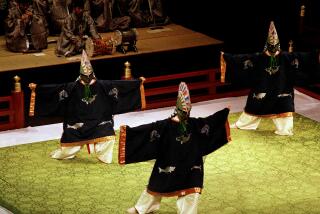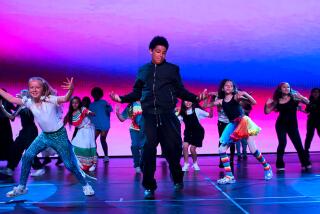Choreographer Tries to Get Back to the Basics : Dance: Karen Goodman objects to the use of mixed media and performance art elements.
- Share via
“I’m not happy with what I see in dance now,” declares dancer-choreographer Karen Goodman, winner of the 1985 Vanguard Award for Choreographic Innovation.
“It looks good while I’m watching it,” she says, “but it doesn’t stick in my mind. There should be an after-image. I want to feel that dance, to see the dance, when I wake up the next morning.”
A former president of the Dance Resource Center, a service organization of the local dance community, Goodman, 42, finds the art of dance sinking into a secondary or subordinate position. She says that too many choreographers nationwide use mixed media and elements from performance art “as an easy way out.”
“I’m talking about those people who are saying ‘I’m a choreographer--let me tell you in words what I’m doing,’ ” she explains, “or, ‘let the composer set the tempo, set the structure.’ ” To her, that’s an evasion of responsibility.
Heavily influenced by the minimalist precepts of the Judson Church innovators and her ensuing work with Gloria Newman, Rudy Perez, and Dance/L.A., Goodman was a founder of the experimental Eyes Wide Open company locally and the head of her own company from 1983-’84. Now a soloist, she finds it mandatory to “get back to the basics.”
“It’s important,” Goodman says, “to experience dance intensely. If I am a dancer, then I will say whatever I have to say with movement. Our bodies experience everything in both the inner and outer worlds. We can learn and express so much. I want to make pieces that do that.
“What we see in the media is all gloss, fast, perfect. I’m taking all the things I deal with in dance and life: dynamics, spatial issues, physical issues and communication. I’m showing the breathing, sweat, tiredness, instead of painting a pretty picture.”
The result is her first solo in two years. “Outer Reaches,” a 50-minute work (to be seen at Highways in Santa Monica tonight, Friday and Saturday) has no music, dialogue, scenery or costume design. The only collaborative accompaniment is lighting designed by Marianne Schneller, winner of the 1988 Drama-Logue Award for lighting design on “Kingfish” at Los Angeles Theatre Center.
Goodman partly blames the trend toward diluting the art of dance on “a culture that doesn’t give a particular value to dance” and also cites the governmental attitude toward dance funding. She agrees that crises such as AIDS and the homeless must take priority, but she questions the mindset that robs from the National Endowment for the Arts instead of raiding the vast military budget.
“The government uses the arts as a whipping boy. It forgets that the money it gives the arts is minuscule,” says Goodman, who earns her living as a modern-dance teacher and renting her studio.
“What I hear in the Dance Resource Center is that there’s a feeling of being invisible. It comes out in complaints about not getting a fair shake of NEA money,” she says sadly.
An endowment bankroll provides the dance company or soloist with an equivalent to the Good Housekeeping Seal of approval. Without it, Goodman says, “choreographers start to look around for things that are going to get them attention--things that are not dance.”
“You say, ‘What can I add? Whose art? Maybe if I use Dolly Parton or Sting, I can make some money at what I do. I’ll do a dance about AIDS or the homeless. It may not be good dance, or it may have nothing to do with dance, but it will get funding.” Not necessarily from the national endowment, but from presenters less interested in choreography than what Goodman calls “the cause of the day.”
Goodman says that the choreographer who does this “is grasping at straws.” But why does she see it the other way and hope that others will, too?
“Because I’m a dancer,” she answers. “I love dance.”
“If dance is supposed to be an art form, I want to see it up there with the other art forms. I expect it to carry as much weight and do what other art forms do--or it’s not a major art form. It is minor.
“I don’t want to think I’ve been spending all these years in a minor art form. It’s time to let dance speak for itself.”
More to Read
The biggest entertainment stories
Get our big stories about Hollywood, film, television, music, arts, culture and more right in your inbox as soon as they publish.
You may occasionally receive promotional content from the Los Angeles Times.










